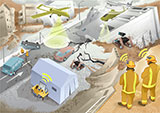EC funds ICARUS project to save more lives in catastrophe situations with robots
The earthquake and tsunami in Japan just over a year ago quickly plunged half the country into chaos. Coordinating rescue efforts in such disaster zones is often challenging and the search for survivors is particularly difficult on such a terrain and even life-threatening for rescue teams. Getting trained search and rescue teams on-site takes often far too long, despite the fact that every second counts in the search for survivors.
The Costa Concordia disaster, near the Italian island Giglio at the beginning of the year, re-sparked anxiety among the general public about danger at high sea. Following these events, last February, the EU launched the ICARUS* project to develop technology that minimizes the number of victims in such catastrophes by improving search and rescue operations. The project, started in February 2012, is funded by the European Commission and is foreseen to cost 17.5 million euro. ICARUS aims to develop over the next four years a number of different unmanned vehicles that will support rescue teams over land, air and sea. These vehicles will rely heavily on thermal image sensors, video processing and data fusion to find persons in dangerous situations.
Apart from the Fraunhofer IZM research group Interconnection Metallurgy and Processes (IMP), the project consortium includes 24 participants from 10 countries. Together with the Université de Neuchâtel and the TU Vienna, Fraunhofer IZM will develop a super lightweight thermal imaging system with minimized dimensions and low power requirements.
The system will feature two cameras, whose image data will be evaluated using fusion algorithms (developed by the project partners RMA Belgium and ETH Zürich). Due to the combination of the innovative camera system with these algorithms, human survivors trapped under rubble or lost at sea can be identified with extreme accuracy.
One of the two cameras uses a commercially available microbolometric sensor, while the other is being purpose-built for the ICARUS project. Although microbolometric cameras provide high-resolution video images, they cannot record spectral information. The second camera, which will be based on highly sensitive quantal cascade detectors (QCDs) of the Université de Neuchâtel, will supply this function. The system will allow search and rescue teams to reliably distinguish people from other objects that also emit thermal radiation. The underlying semiconductor system is based on a wavelength of 9.5 µm, which is the main radiation wavelength at human body temperature. By integrating the two cameras, which complement each other in terms of resolution characteristics and technologies, the project consortium will develop a high-performance system.
Developing packaging technology for disaster zones, which are very hostile to electronics (e.g. heat and cold, humidity and damp), is a challenging task. The camera systems will also be exposed to extreme mechanical stresses since they will be attached to vehicles that will move trough land, air and sea.
In this sense, Fraunhofer IZM is developing a specialized integration and packaging technology to meet the strict reliability requirements and those of the interconnection between the individual components and the QCD camera’s “periphery”.
At -50 °C, the operating temperature of the OCD camera system’s sensors is another challenge. A multistage Peltier cooler is being included to ensure the operating temperature is kept stable across the wide range of environmental temperatures the system is intended for, namely, from -20 to +50 °C. To prevent condensation forming on the sensor surfaces, the package is being mounted in a vacuum-hermetic casing.
Fraunhofer IZM is using sensor chips which are thinned by TU Vienna, to keep the package dimensions small despite the required housing. These Chips will be assembled onto a CMOS-Read out chip by stud bump flip chip bonding. Extremely precise positioning is necessary, as the pitch of the interconnections of the pixels is planned between 50 to 120 µm. The package will also have to be commercially manufactured at high yield, which poses an additional challenge.
*Integrated Components for Assisted Rescue and Unmanned Search Operations
Last modified:
 Fraunhofer Institute for Reliability and Microintegration IZM
Fraunhofer Institute for Reliability and Microintegration IZM